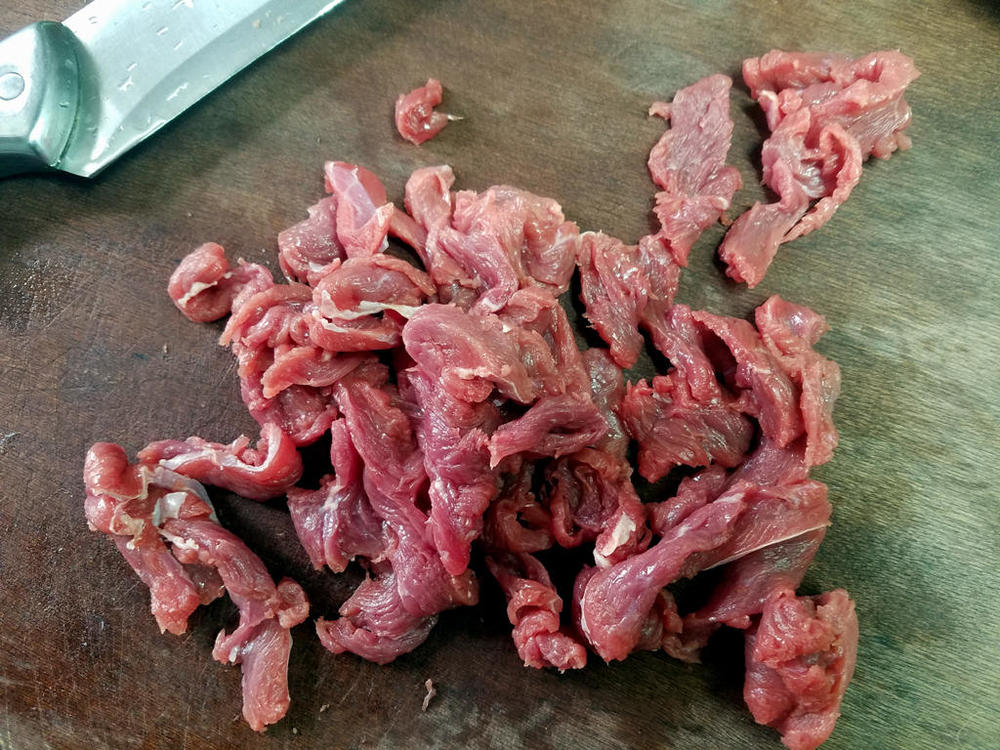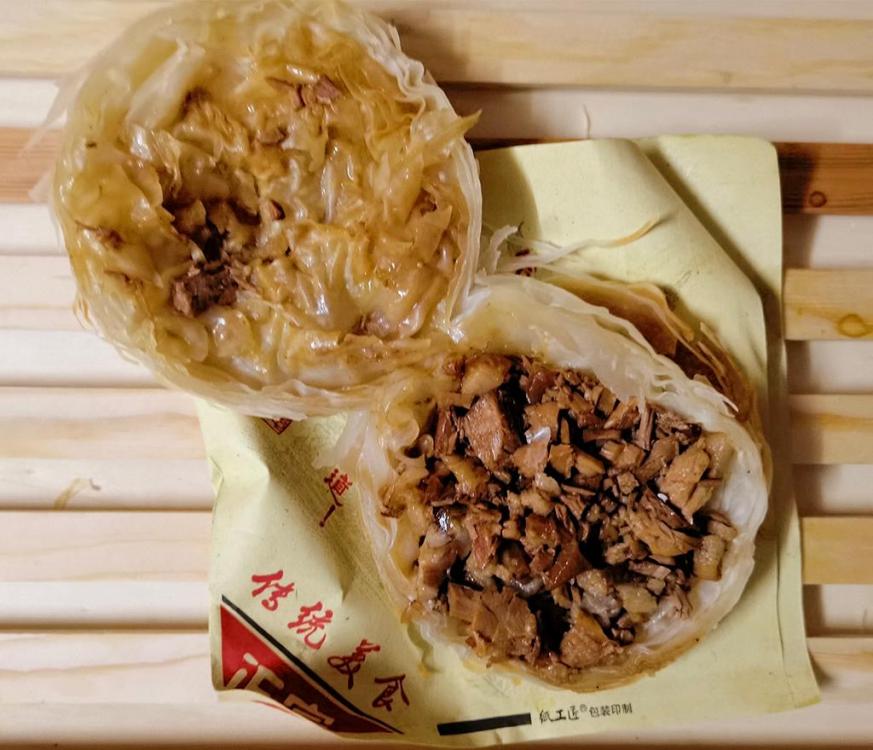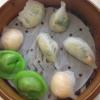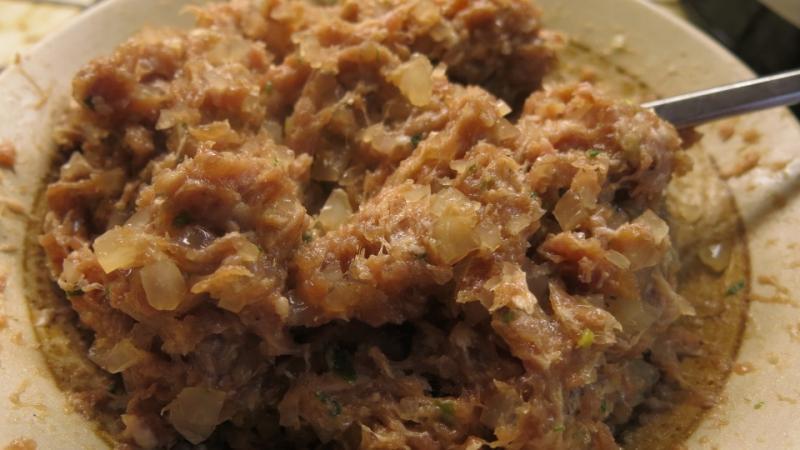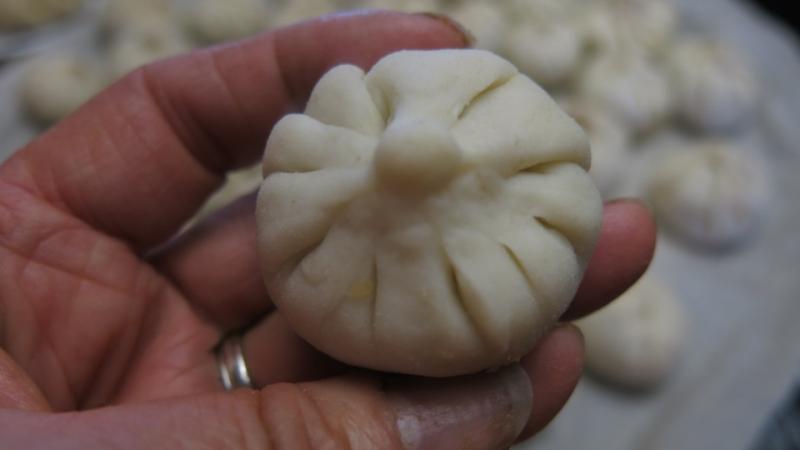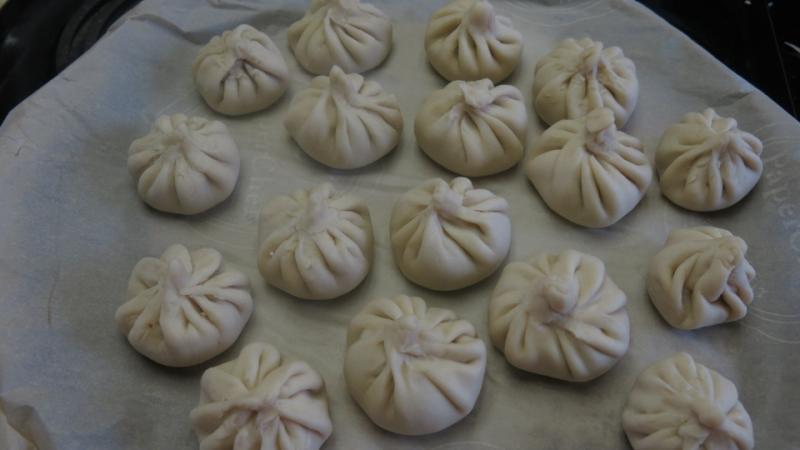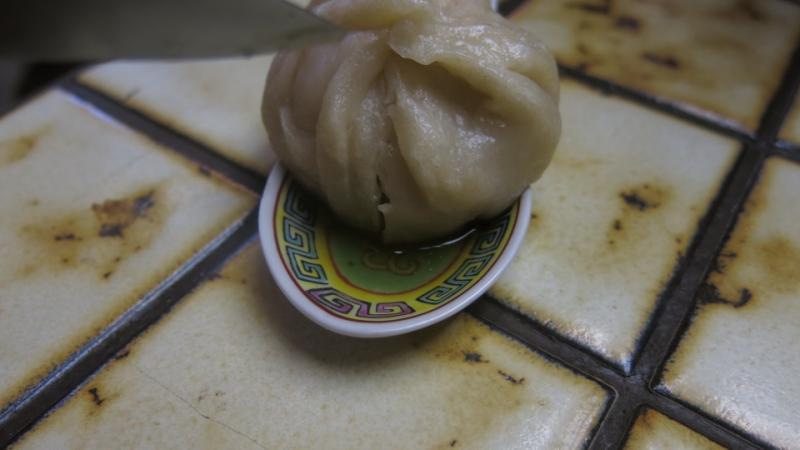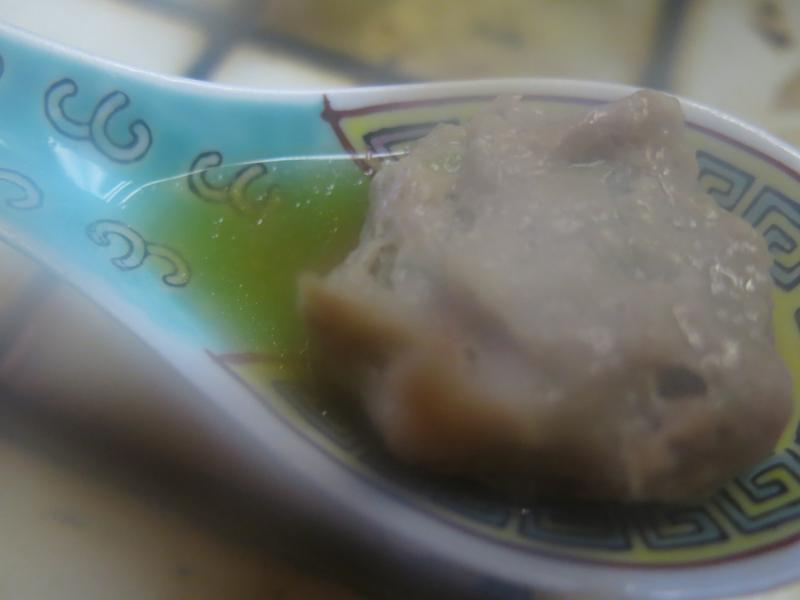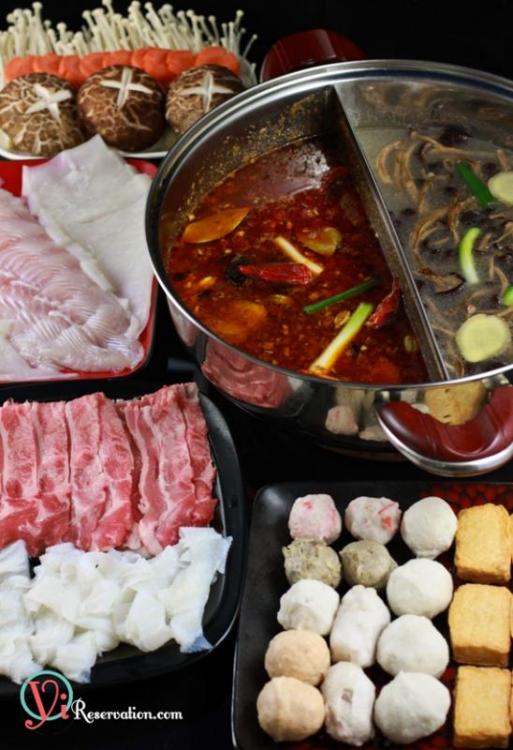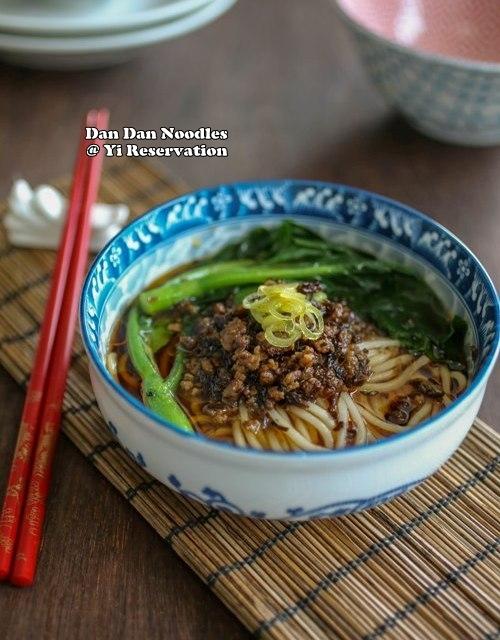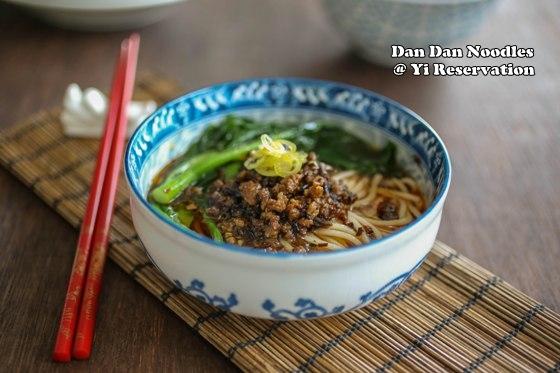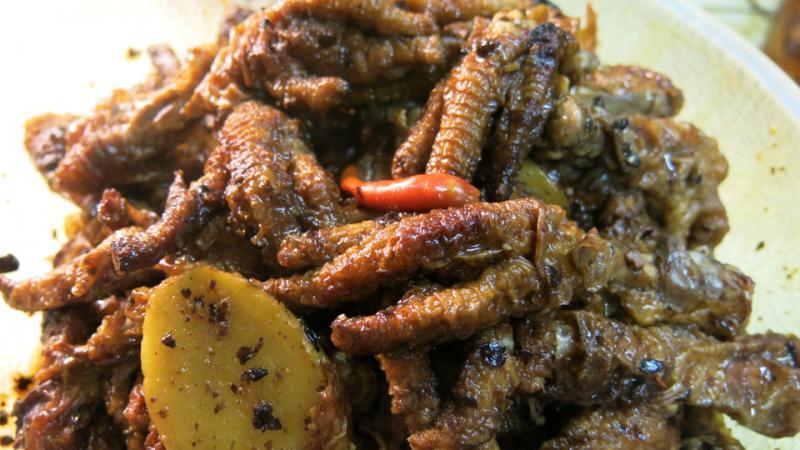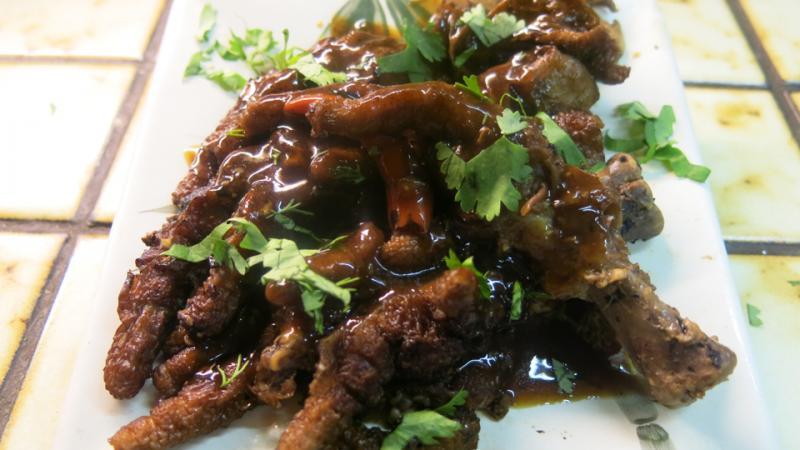Search the Community
Showing results for tags 'Chinese'.
-
I'm probably the worst person to kick off a Chinese Dessert thread. I have the least sweet tooth on the planet, but I know there is interest in the topic. I often read that the Chinese don't do dessert. Not quite true. They don't necessarily serve sweet dishes at the end of a meal, but they may turn up midway through. Chinese food is not normally served in a strict order, serial way. That said, it is not uncommon to finish a no dessert meal then head for one of the many places selling only desserts. Sweet yoghurt, cakes, candied fruits etc are everywhere.
-
Described as pancakes, crepe like with a some spicy seasoning in the middle... thoughts? Also in China.
-
So... I found a wonderfully simple recipe for Chinese Broccoli. Everything was straight-forward ,easy really, until I saw baking soda on the ingredient list. Now, obviously, I can get that ingredient easily. But my question is: Why do I need it? Comments?
-
I found this series on CCTV english The contrasting tastes of Harbin Luzhou's taste of intoxication Hengyang's vegetarian's delight Ningbo's Original Flavors The Wild Flavors of Xi'an Zibo Snacks Whole Food for Whole People The Exotic Flavors of Yanbian Guangzhou Snacks - Taste of Good Fortune Huangshan's Natural Taste A Taste of the Sea in Beihai
-
Hi all, is it practical to make your own conpoy (dried scallops)? I have recently made a batch of XO sauce and want to try some more variations but the problem is getting conpoy at a reasonable price. I have had to pay $18 for 100g and I can buy great frozen scallops for <$20 per Kg. I would expect that the drying would result in a dry weight of about 20% but this would be half the cost of buying conpoy. Has anybody tried this or know of a good method? Ar they cured or cooked before drying? Thanks Simon
-
These have been mentioned a couple of times recently on different threads and I felt they deserved one of their own. After all, they did keep me alive when I lived in Xi'an. Rou jia mo (ròu jiá mò; literally "Meat Sandwich") are Chinese sandwiches which originated in Shaanxi Province, but can be found all over China. Away from their point of origin, they tend to be made with long stewed pork belly. However in Xi'an (capital of Shaanxi), there is a large Muslim population so the meat of choice is more usually beef. In nearby Gansu Province, lamb or mutton is more likely. Stewed Belly Pork Rou Jia Mo When I was living in Xi'an in 1996-1997, I lived on these. I was living on campus in North-West University (西北大学) and right outside the school gate was a street lined with cheap food joints, most of which would serve you one. I had one favourite place which I still head to when I visit. First thing I do when I get off the train. What I like to eat is Cumin Beef Rou Jia Mo (孜然牛肉夹馍 zī rán niú ròu jiá mò). The beef is stir fried or grilled/BBQd with cumin and mild green peppers. It is also given a bit of a kick with red chill flakes. Here is a recipe wrested from the owner of my Xi'an favourite. So simple, yet so delicious. Lean Beef Fairly lean beef is cut into slivers Sliced Beef Chopped garlic I use this single clove garlic from Sichuan, but regular garlic does just fine. The beef and garlic are mixed in a bowl and generously sprinkled with ground cumin. This is then moistened with a little light soy sauce and Shaoxing wine. You don't want to flood it. Set aside for as long as you can. Mild Green Chilli Pepper Take one or two mild green peppers and crush with the back of a knife, then slice roughly. You could de-seed if you prefer. I don't bother. Chopped Green Pepper Fire up the wok, add oil (I use rice bran oil, but any vegetable oil except olive oil would be fine) and stir fry the meat mixture until the meat is just done. Frying Tonight Then add the green peppers and fry until they are as you prefer them. I tend to like them still with a bit of crunch, so slightly under-cook them In with the peppers You will, of course, have prepared the bread. The sandwiches are made with a type of flat bread known as 白吉饼 (bái jí bǐng; literally "white lucky cake-shape"). The ones here are store bought but I often make them. Recipe below. Bai Ji Bing Take one and split it. Test the seasoning of the filling, adding salt if necessary. It may not need it because of the soy sauce. Nearly there Cover to make a sandwich and enjoy. You will see that I have used a bunch of kitchen paper to hold the sandwich and to soak up any escaping juices. But it should be fairly dry. The final product. Note: I usually cook the meat and pepper in batches. Enough for one sandwich per person at a time. If we need another (and we usually do) I start the next batch. Bread Recipe 350g plain flour 140ml water 1/2 teaspoon instant yeast Mix the yeast with the flour and stir in the water. Continue stirring until a dough forms. Knead until smooth. Cover with a damp towel or plastic wrap and leave to rise by about one third. (maybe 30-40 minutes). Knead again to remove any air then roll the dough into a log shape around 5cm in diameter, then cut into six portions. Press these into a circle shape using a rolling pin. You want to end up with 1.5cm thick buns. Preheat oven to 190C/370F. Dry fry the buns in a skillet until they take on some colour about a minute or less on each side, then finish in the oven for ten minutes. Allow to cool before using.
-
So the other day I bought one of those Thai grills/charcoal wok stoves, for getting serious damn heat outdoors when stir frying. Loaded it up with hot charcoal tonight and sure enough it got HOT. So hot that when I added my marinaded chicken cubes, a portion of chicken literally exploded out of the wok and headed straight for me, burning my arm in the process. What didn't hit my arm travelled a good 5 feet or so. I guess maybe the chicken was too wet? Is one not supposed to marinade meat when dealing with such high temperatures? I imagine it still wasn't as hot as a commercial wok range, but then also I'm using a 14" wok, as opposed to a much larger one typical for such a high-heat application. Basically, I got this grill in part to get searing heat and super wok hei, which I achieved...so how do I prevent further injury?
-
I recently purchased a bottle of Lee Kum Kee premium oyster sauce, which has been my go-to choice for quite some time. However, I hadn't purchased it for a couple-three years. When I used it last night I was somewhat disappointed - it didn't taste the way I remembered it. Could be the sauce has changed, or, more likely, my palate has changed. In any case, I'd like to experiment with some different options. What suggestions do the oyster sauce sophisticates have to offer? Maybe something not as salty, or less filled with additives and coloring? I've heard that some Thai oyster sauces are an improvement over LKK. Any suggestions in that regard?
-
Can you watch these and tell me how and the ingredients they use to make this chicken? I like the uniform color of the chicken. I don’t understand Taiwanese. Seems they: 1. poach chicken dark color liquid, What's in the liquid (e.g. water, soy sauce, green onions, red vinegar, star anise, etc . . .)? How many minutes poach? 2. Cool off chicken in cold water. 3. brush chicken with liquid, What's in the liquid (e.g. soy sauce, maltose, vinegar, etc . . .)?t 4. roast in urn 200 celsius, then lower to what degree? How long (minutes)? http://www.youtube.com/watch?v=Jql_mlXdRcs http://www.youtube.com/watch?v=nOueACwA9IY http://www.youtube.com/watch?v=Vc2ZZ9qRd7Q http://www.youtube.com/watch?v=LJaB0tUtWVc I ilke to try and repeat this method at home in pot and oven. TIA
-
Hi everyone, I am new to the forum. Looking for ways to ask all the asian cooking questions I have. The first is this. I have a Masterstock recipe I want to try. Once I'm done, I plan to cool it, skim the fat, strain it and freeze it, with the hope I can develop it over a number of years. Different recipes say different things as far as what to do when you bring it out. Is it right bring the frozen masterstock to boil, add the aromatics (ginger, cassia bark, star ainise, rock sugar, orange peel) as well as the sauces (light soy, dark soy, shaoxing wine etc) again into the stock? Or do I just leave it? Thanks!
-
I guess I do about half my food shopping in my local farmers' market and the other half in supermarkets. Today, I went to my favourite supermarket. They have lovely, very fresh vegetables, great fish and well... there isn't much they don't have. Here are a few pictures, beginning with the vegetable section:
-
My post is two-fold. Are there any experts on Taiwanese cuisine out there? My family is Taiwanese---I am American-born. I can navigate Mandarin (conversation) but am illiterate (my parents are bitterly disappointed.) I love going back to see family and they feed me well...but much of the time I don't know what I'm eating and we don't know how to communicate. Is there an authoritative Taiwanese cookbook? My uncles and aunts and etc speak mostly Taiwanese (Fujianese if you will) exclusively and I don't know any at all, beyond a few insults and very few foods. Since it isn't a written language AND i'm illiterate anyway, I don't have a way for googling some of the dishes I really love. Unrelated, but still puzzling note---the majority of Chinese grocery stores here are Cantonese speakers, and I don't understand Cantonese at all. Is the cantonese "choy" the same as the mandarin word "tsai?"
-
Hi there! I've had this ingredient in my cupboard for months and never figured out how to use it. Does anybody have tips on how to get the most out of this pepper?
-
A few weeks ago I bought a copy of this cookbook which is a best-selling spin off from the highly successful television series by China Central Television - A Bite of China as discussed on this thread. . The book was published in August 2013 and is by Chen Zhitian (陈志田 - chén zhì tián). It is only available in Chinese (so far). There are a number of books related to the television series but this is the only one which seems to be legitimate. It certainly has the high production standards of the television show. Beautifully photographed and with (relatively) clear details in the recipes. Here is a sample page. Unlike in most western cookbooks, recipes are not listed by main ingredient. They are set out in six vaguely defined chapters. So, if you are looking for a duck dish, for example, you'll have to go through the whole contents list. I've never seen an index in any Chinese book on any subject. In order to demonstrate the breadth of recipes in the book and perhaps to be of interest to forum members who want to know what is in a popular Chinese recipe book, I have sort of translated the contents list - 187 recipes. This is always problematic. Very often Chinese dishes are very cryptically named. This list contains some literal translations. For some dishes I have totally ignored the given name and given a brief description instead. Any Chinese in the list refers to place names. Some dishes I have left with literal translations of their cryptic names, just for amusement value. I am not happy with some of the "translations" and will work on improving them. I am also certain there are errors in there, too. Back in 2008, the Chinese government issued a list of official dish translations for the Beijing Olympics. It is full of weird translations and total errors, too. Interestingly, few of the dishes in the book are on that list. Anyway, for what it is worth, the book's content list is here (Word document) or here (PDF file). If anyone is interested in more information on a dish, please ask. For copyright reasons, I can't reproduce the dishes here exactly, but can certainly describe them. Another problem is that many Chinese recipes are vague in the extreme. I'm not one to slavishly follow instructions, but saying "enough meat" in a recipe is not very helpful. This book gives details (by weight) for the main ingredients, but goes vague on most condiments. For example, the first dish (Dezhou Braised Chicken), calls for precisely 1500g of chicken, 50g dried mushroom, 20g sliced ginger and 10g of scallion. It then lists cassia bark, caoguo, unspecified herbs, Chinese cardamom, fennel seed, star anise, salt, sodium bicarbonate and cooking wine without suggesting any quantities. It then goes back to ask for 35g of maltose syrup, a soupçon of cloves, and "the correct quantity" of soy sauce. Cooking instructions can be equally vague. "Cook until cooked". A Bite of China - 舌尖上的中国- ISBN 978-7-5113-3940-9
-
I found the recipe and post from rarerollingobject too late for my experiment this past weekend. I will refer to her the next session. This was my first attempt while my s-i-l was out for the weekend. He's a big Scottish lad who loves dim sum. While my daughter is away on a course, he wanted to try his hand on these dumplings and surprise her when she gets home this weekend. The filling and gelatin were spot on. The wrappers definitely need thinning out. Not too shabby for a first attempt. We ate many of these taste testing, so it ended up being an all day lunch or supper... If anyone has a great recipe for the wrappers or tried and true technique, please share! Gelatin was made from 2 skin-on pork hocks, the bone and skin from a fresh pork picnic, big nob of ginger, scallions, and 1 pkg of unflavoured gelatin to 4 cups stock. Filling was ground pork, shrimp, scallions, white pepper, Chinese cooking wine, grated ginger, salt, and soy sauce. We incorporated small bits of gelatin in the meat as well as adding a small cube on top before pleating and closing the wrapper. The baos got smaller and pleats were better as the experiment progressed There was a fair bit of soup in the baos, but the wrapper needs to be thinner. We didn't eat many of the wrappers, but the meat and soup were great! The granddogs enjoyed some of the wrappers.
-
In this cold winter, there is nothing better than sharing a spicy Sichuan hot pot with your friends and family. For the uninitiated, Chinese hot pot, a.k.a. huo guo (火鍋), is a group dining activity where a pot of boiling broth is shared. Friends and families cook the raw ingredients of their liking in this communal pot of broth while chitchatting, laughing, and enjoying each other’s company by the table-side. This recipe is for a popular regional hot pot from Sichuan (Szechuan). The broth is infused with lots of aromatic spices, fiery chili oil and tongue-numbing Sichuan peppercorn so it is very fragrant and spicy! This is a make from scratch recipe that I first posted on my blog. If you like to learn visually, I'd recommend you to visit my blog (link in my profile) for the step by step pictorial recipe. Enjoy! Ingredients: For Master sauce (adjust to your own spiciness) 3 tbsp Sichuan Spicy Bean Paste 5 Dried chili, soaked until soft. 1 tbsp Chinese Black Bean 4 slice Ginger, 4 glove Garlic ½ cup Cooking Wine 1tbsp Rock Sugar Dry Spices: 3 star anise, 1tbsp Sichuan Peppercorn, 1 black cardamom, 4 green cardamom, 2 sand ginger, 1 piece cinnamon stick, and 1 tbsp fennel seeds For the stock: 2 lb Beef or Pork or Chicken bones. 3 slice Ginger 2 Scallion 3 Bay leaf 1 gallon water Instructions: The recipe is for half of a 12 inch special pot. Adjust the amount accordingly. 1. Make the base stock by combining beef or pork bones or chicken skeleton with water, ginger, scallion, bay leaves. Broil and simmer for 3 hours. Can be made in advance. 2. The master sauce is the soul of Sichuan hot pot (and is guarded by restaurant owners as top secret but today you’ll get it for free). I recommend making this in advance. To make the aged-spicy paste: chop the Sichuan Spicy Bean Paste, soaked dry chili, ginger, garlic, and black bean. Combine 4 tbsp of oil and all the chopped ingredients, cook in low heat for 10 minutes. Stir frequently. Add the rest of the dry spices and cooking wine and sugar to the paste. Continue to cook in low heat for another 30 minutes then turn off the heat. This is your aged-spicy taste and can be made in advance. 3. Before serving the hot pot, combine the aged-spicy paste with base stock and bring to boil. Add additional ginger, dried chili, and salt to taste. 4. To make the special peanut butter sesame dipping sauce, combine the peanut butter, sesame paste, and fermented bean curd. Mix into a paste. Add oyster sauce, sugar, chopped chive flower and mix well.
-
Hi. I need a little help planning my dinner for Chinese New Year. My mother in law already called to say they are coming here. My husband thinks I'm ambitious to cook a whole Chinese dinner for New Year. I just think that if I carefully plan, I could do a good job. His family is Shanghainese so I'd like to cook things to surprise his parents. I think in egullet there is somewhere Rarerollingobject recipe (where are you, dear RRO?) for xiaolongbao and I'd like to make those. Definitely some steamed fish and some easy saute' vegetables, eight treasure pudding and some tang yuan and for sure Sunflower's pork belly which is spectacular. Any other idea?
-
Thought of a forgotten snack that I've only had once in my life and am on the search for it. It is challenging to find online and I can not find it in any of our three Asian grocery stores. They are chewy, the skins are wrinkly, and they salty and delicious. Here is a photo. I have found a few pages online which refer to it but the translations are loose: http://bit.ly/1dzrB28 http://bit.ly/1cPV9Zg Is anyone familiar with this and can anyone help with a good recipe source or post here?
-
For those of you frequent Sichuan (Szechuan) eateries, you probably know that Dan Dan Noodles is arguably one of the must-try dishes at any Sichuan restaurants. In fact it’s so popular that this spicy, sweet, and tangy noodle dish has often used to measure how authentic a restaurant is! This is a recipe I learned from growing up in Sichuan and imho it's so much better than the restaurant version. If you like to learn with pictures please check out my blog for step-by-step pictorial recipe! Ingredients: 6oz fresh Chinese noodles (can substitute with dry noodles) Handful of fresh leafy vegetables such as spinach Dan Dan Meat Topping: 4oz ground pork 4oz [ya cai (preserved mustard green from Sichuan), chopped 2tbsp soy sauce 1tbsp Chinese cooking wine 1tsp five spice powder Dan Dan Sauce: 2tsp garlic, grated 2tsp Chinese sesame paste 4tbsp soy sauce 1tsp Sichuan peppercorn powder 1tsp sugar 4tbsp chili oil (more if you can handle the heat) 1tsp sesame oil 2tbsp Chinese black vinegar 1cup hot chicken or pork stock, unsalted (can substitute with boiled water) Chopped scallions for garnish Instructions: To make the meat topping: sauté ground pork and ya cai in 1 tbsp of cooking oil over high heat. When the meat turns color, add soy sauce, cooking wine, and five spice powder. Cook for another 3 minutes. Set aside To build the Dan Dan Noodle sauce: combine the garlic and sesame paste in a bowl. Mix using a spoon until smooth Add the rest of the sauce ingredients except the scallions. Stir until well incorporated While building the sauce, cook the noodles in a pot of boiling water until al dente. If using fresh noodles, it should take about 3 – 4 minutes Cook the vegetable in the same pot. To get the best noodle texture, shock the noodles in ice water right after cooking to stop the noodles from cooking Drain the excess water and drop the noodles into the sauce. Add the meat topping and garnish with scallions. Feel free to add additional chili oil according to your own taste
-
Perhaps the food-related question I get asked most through my blog is “What's it like for vegetarians and vegans in China. The same question came up recently on another thread, so I put this together. Hope it's useful. It would also, be great to hear other people's experience and solutions. For the sake of typing convenience I’m going to conflate 'vegetarians and vegan' into just 'vegetarian' except where strictly relevant. First a declaration of non-interest. I am very carnivorous, but I have known vegetarians who have passed through China, some staying only a few weeks, others staying for years. Being vegetarian in China is a complicated issue. In some ways, China is probably one of the best countries in which to be vegetarian. In other ways, it is one of the worst. I spent a couple of years in Gorbachev-era Russia and saw the empty supermarkets and markets. I saw people line up for hours to buy a bit of bread. So, when I first came to China, I kind of expected the same. Instead, the first market I visited astounded me. The place was piled high with food, including around 30 different types of tofu, countless varieties of steamed buns and flat breads and scores of different vegetables, both fresh and preserved, most of which I didn't recognise. And so cheap I could hardly convert into any western currency. If you are able to self-cater then China is heaven for vegetarians. For short term visitors dependent on restaurants or street food, the story is very different. Despite the perception of a Buddhist tradition (not that strong, actually), very few Chinese are vegetarian and many just do not understand the concept. Explaining in a restaurant that you don't eat meat is no guarantee that you won't be served meat. Meat is seen in China as a status symbol. If you are rich, you eat more meat. And everyone knows all foreigners are rich, so of course they eat meat! Meat eating is very much on the rise as China gets more rich - even to the extent of worrying many economists, food scientists etc. who fear the demand is pushing up prices and is environmentally dangerous. But that's another issue. Obesity is also more and more of a problem. Banquet meals as served in large hotels and banquet dedicated restaurants will typically have a lot more meat dishes than a smaller family restaurant. Also, the amount of meat in any dish will be greater in the banquet style places. Traditional Chinese cooking is/was very vegetable orientated. I still see my neighbours come home from the market with their catch of greenery every morning. However, whereas meat wasn't the central component of dinner, it was used almost as a condiment or seasoning. Your stir fried tofu dish may come with a scattering of ground pork on top, for example. This will not usually be mentioned on the menu. Simple stir fried vegetables are often cooked in lard (pig fat) to 'improve' the flavour. Another problem is that the Chinese word for meat (肉), when used on its own refers to pork. Other meats are specified, eg (beef) is 牛肉, literally cattle meat. What this means is that when you say you don't eat meat, they often think you mean you don't eat pork (something they do understand from the Chinese Muslim community), so they rush off to the kitchen and cook you up some stir fried chicken! I've actually heard a waitress saying to someone that chicken isn't meat. Also, few Chinese wait staff or cooks seem to know that ham is pig meat. I have also had a waitress argue ferociously with me that the unasked for ham in a dish of egg fried rice wasn't meat. Also, Chinese restaurant dishes are often given have really flowery, poetic names which tell you nothing of the contents. Chinese speakers have to ask. One dish on my local restaurant menu reads “Maternal Grandmother's Fluttering Fragrance.” It is, of course, spicy pork ribs! Away from the tourist places, where you probably don't want to be eating anyway, very few restaurants will have translations of any sort. Even the best places' translations will be indecipherable. I have been in restaurants where they have supplied an “English menu”, but if I didn't know Chinese would have been unable to order anything. It was gibberish. To go back to Buddhism and Taoism, it is a mistake to assume that genuine followers of either (or more usually a mix of the two) are necessarily vegetarian. Many Chinese Buddhists are not. In fact, the Dalai Lama states in his autobiography that he is not vegetarian. It would be very difficult to survive in Tibet on a vegetarian diet. There are vegetarian restaurants in many places (although the ones around where I am never seem to last more than six months). In the larger cities such as Beijing and Shanghai they are more easily findable. Curiously, many of these restaurants make a point of emulating meat dishes. The menu reads like any meat using restaurant, but the “meat” is made from vegetable substitutes (often wheat gluten or konjac based). To be continued
-
I had some Jiaozi type dumplings when I was in Chengdu last year. The sauce which I had with them was absolutely divine tasting. Does anybody have any great recipes for sauces for eating with Chinese dumplings. The one I had from what I remember was quite reddish in colour; it obviously had chillio oil in it. It also had pieces or coriander in it. I think maybe some vinegar and soy sauce too. I've tried to re-create it from recipees I've seen on the web but my efforts haven't been up to the mark. Do you have any recipes/suggestions? Thanks.
-
I haven't made these for a long time, but a friend just gave me 10 lbs of cleaned plump chicken feet. Cantonese dim sum style Golden Phoenix Palms is not easy to come by in our small city. I love these and decided I needed to make a pile and have ready in the freezer for a treat anytime! The set up for deep frying outside. Once brown and crispy, the feet were tossed into a pot of ice water. Sizzling in the wok of hot oil. I had the flame on high. There was a lot of splattering, but I didn't care - nothing to clean up in the house and I stayed far away after I first put them in: The feet were simmered for 1.5 hours The simmered feet were drained, cooled then coated with a marinade to sit overnight. Steamed for 15 minutes and ready to enjoy!
-
I frequently hear that true Chinese stir-fries can't be cooked in home stoves because they aren't hot enough. I'm curious to hear what fellow egulleters think about this. I often cook Chinese food at home on my 20-year old average gas stove and I think that I am getting good results. I am able to get brown spots on veggies and proteins without overcooking the interior, on medium-high heat. I find that when I turn the heat all the way to high, I need to move faster and because precise timing is more important, I'm more likely to make mistakes (e.g. sometimes the oil will overheat, or veggies get a bit too scorched). In other words, I don't feel limited by the heat level of my old gas stove. I understand that in Chinese restaurants they have crazy hot stoves - I heard 200 BTU (is this even possible?) I have no doubt that professional cooks can handle the speed and precision of 200 BTU, but I'm wondering if that's really necessary to achieve the "wok hai" that we associate with a good stir-fry. There is no controversy in the fact that home stoves are capable of causing the Maillard reaction in western cooking. Meaning, we can all cook a thin piece of fish or meat that browns on the outside without overcooking on the inside. I don't see how this is different from wok cooking. Or am I not thinking correctly? Would love to hear your thoughts!





